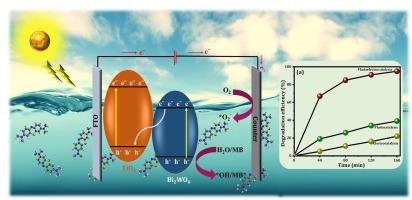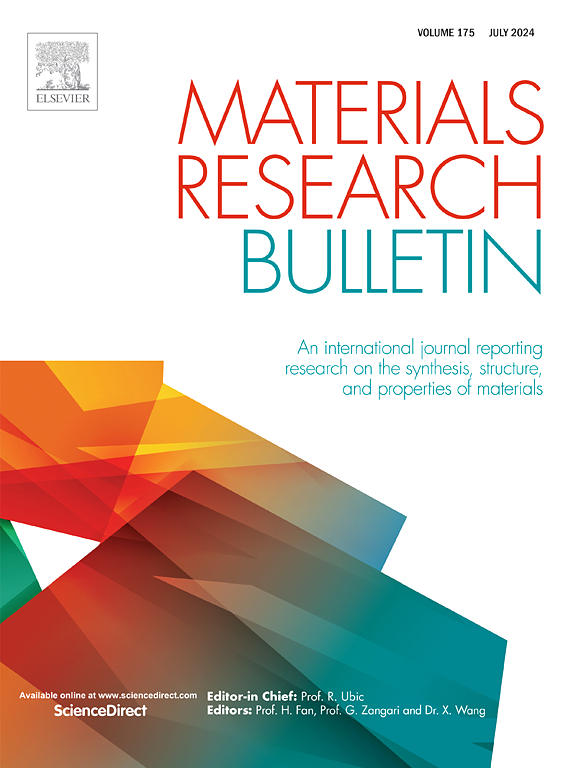Photoelectrocatalytic degradation of organic contaminants by spray coated Z-scheme TiO2/Bi2WO6 heterostructure electrode under solar light
IF 5.3
3区 材料科学
Q2 MATERIALS SCIENCE, MULTIDISCIPLINARY
引用次数: 0
Abstract
This study demonstrates that spray deposited layered TiO2/Bi2WO6 heterostructure photoelectrodes exhibit strong interfacial interactions, leading to significant enhancements in photoelectrochemical performance. Time-resolved photoluminescence (TRPL) spectra indicated a prolonged lifetime of photoinduced carriers. The red shift in the absorption edge of TiO2/Bi2WO6 improved the visible light harvesting capability of Bi2WO6. Nyquist plots showed effective charge separation, and the TiO2 layer at the bottom significantly influenced the flat band potential compared to pristine Bi2WO6, as evidenced by Mott-Schottky analysis. This configuration improved the separation of photogenerated charge carriers via a Z-scheme charge transfer mechanism. The TiO2/Bi2WO6 electrode demonstrated a higher efficiency of 94% for methylene blue degradation within 160 min, compared to pure Bi2WO6. Quenching experiments confirmed the Z-scheme charge transfer mechanism in the coupled TiO2/Bi2WO6 heterojunction during degradation reactions. This study highlights the benefits of semiconductor coupling with different band potentials, promoting large-scale applications of solar-driven TiO2/Bi2WO6 photoelectrodes for environmental remediation.

喷涂 Z 型 TiO2/Bi2WO6 异质结构电极在太阳光下光电催化降解有机污染物
这项研究表明,喷涂沉积的层状 TiO2/Bi2WO6 异质结构光电极表现出很强的界面相互作用,从而显著提高了光电化学性能。时间分辨光致发光(TRPL)光谱显示,光诱导载流子的寿命延长。TiO2/Bi2WO6 吸收边的红移提高了 Bi2WO6 的可见光收集能力。奈奎斯特图显示了有效的电荷分离,与原始 Bi2WO6 相比,底部的 TiO2 层显著影响了平带电位,Mott-Schottky 分析证明了这一点。这种结构通过 Z 型电荷转移机制改善了光生电荷载流子的分离。与纯 Bi2WO6 相比,TiO2/Bi2WO6 电极在 160 分钟内降解亚甲基蓝的效率高达 94%。淬火实验证实了耦合 TiO2/Bi2WO6 异质结在降解反应过程中的 Z 型电荷转移机制。这项研究强调了不同带电位半导体耦合的益处,促进了太阳能驱动的 TiO2/Bi2WO6 光电电极在环境修复领域的大规模应用。
本文章由计算机程序翻译,如有差异,请以英文原文为准。
求助全文
约1分钟内获得全文
求助全文
来源期刊

Materials Research Bulletin
工程技术-材料科学:综合
CiteScore
9.80
自引率
5.60%
发文量
372
审稿时长
42 days
期刊介绍:
Materials Research Bulletin is an international journal reporting high-impact research on processing-structure-property relationships in functional materials and nanomaterials with interesting electronic, magnetic, optical, thermal, mechanical or catalytic properties. Papers purely on thermodynamics or theoretical calculations (e.g., density functional theory) do not fall within the scope of the journal unless they also demonstrate a clear link to physical properties. Topics covered include functional materials (e.g., dielectrics, pyroelectrics, piezoelectrics, ferroelectrics, relaxors, thermoelectrics, etc.); electrochemistry and solid-state ionics (e.g., photovoltaics, batteries, sensors, and fuel cells); nanomaterials, graphene, and nanocomposites; luminescence and photocatalysis; crystal-structure and defect-structure analysis; novel electronics; non-crystalline solids; flexible electronics; protein-material interactions; and polymeric ion-exchange membranes.
 求助内容:
求助内容: 应助结果提醒方式:
应助结果提醒方式:


